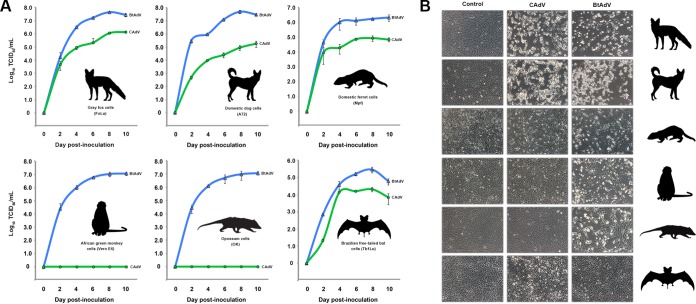FIG 7.
Comparative in vitro host ranges of BtAdV and CAdV. (A) Gray fox (FoLu), domestic dog (A72), domestic ferret (Mpf), African green monkey (Vero E6), Virginia opossum (OK), and Brazilian free-tailed bat (Tb1Lu) cells were infected with either BtAdV 250-A or CAdV-1 (isolate 24-05), and viral titers (log10 TCID50/ml) were measured at 2-day intervals over a 10-day period. BtAdV 250-A growth curves are shown in blue, whereas CAdV 24-05 growth curves are shown in green. Note that although CAdV was host restricted to cells derived from members of the order Carnivora (fox, dog, and ferret) and bats, BtAdV 250-A replicated efficiently in cells derived from a phylogenetically diverse group of mammals, including primates, as well as a marsupial species (opossum). The data shown are from multistep single growth curve experiments performed in triplicate, with error bars indicating the standard deviations. (B) Cell morphology of the cell lines used in panel A at day 6 postinfection with either BtAdV 250-A or CAdV 24-05. Note the induction of cytopathic effects by BtAdV in all of the cell lines tested beside bat (Tb1Lu) cells.

